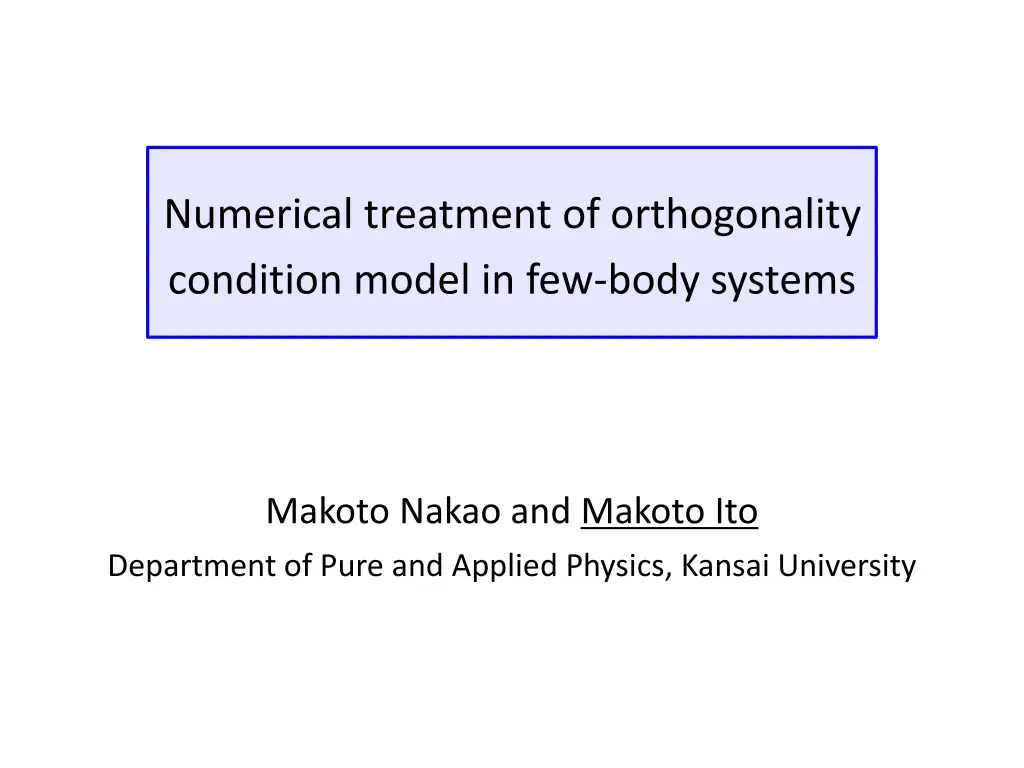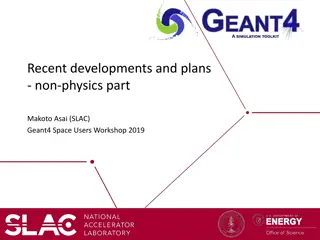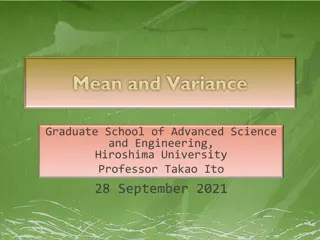
Numerical Treatment of Orthogonality Condition Model
Explore the numerical treatment of the orthogonality condition model in few-body systems, focusing on anti-symmetrization among fermions and the importance of the Orthogonality Condition Model (OCM) in solving few-body problems within allowed functional spaces. Simplifications and transformations of the OCM are discussed, providing a basis for the formulation of Numerical OCM (NOCM) for specific systems like 8Be and 20Ne. Comparison with analytic solutions enhances understanding in this field.
Download Presentation

Please find below an Image/Link to download the presentation.
The content on the website is provided AS IS for your information and personal use only. It may not be sold, licensed, or shared on other websites without obtaining consent from the author. If you encounter any issues during the download, it is possible that the publisher has removed the file from their server.
You are allowed to download the files provided on this website for personal or commercial use, subject to the condition that they are used lawfully. All files are the property of their respective owners.
The content on the website is provided AS IS for your information and personal use only. It may not be sold, licensed, or shared on other websites without obtaining consent from the author.
E N D
Presentation Transcript
Numerical treatment of orthogonality condition model in few-body systems Makoto Nakao and Makoto Ito Department of Pure and Applied Physics, Kansai University
Background 1. Few-Body Problems with fermion-composite systems It is essential to consider the anti-symmetrization among the fermions contained in a building particle ( cluster in nuclei, for instance ) Typical example : 8Be = + , 12C = + + , 20Ne = +16O, 2. Microscopic cluster models Microscopic cluster model is straight forward manner but . ?in(C1) ?in(C2) ? = ? , = ? ? ? ?in(C1)?in(C2) Anti-symmetrizer ? ? Difficult in reproducing internal and relative binding energies 3. Importance of Orthogonality Condition Model (OCM) Functional space allowed by anti-symmetrization are constructed Orthogonal to the forbidden space by the Pauli s exclusion principle Few-body problems are solved within allowed functional space
Orthogonality condition model (OCM) 1. Eigenvalue equation of Norm Kernel A. Saito, Suppl. Prog. Theor. Phy. 62, 11(1977) Anti-symmetrizer ?? = ?C1?C2? ??C1?C2 = ?? Relative w.f. for cluster C1 and C2 Internal w.f. for Cluster1 and 2 SU(3) conf. is employed HO Harmonic Oscillator Basis function HO ?? ? = ???? ? Pauli allowed state ? > 0 ? We can solve the problem within Pauli allowed functional space ( with > 0 ) 2. Coordinate Rep. of eigenvalue equation ? ? ? ?, ? ? ? = ?? ? HO? ? ? = ???? ? RGM Norm Kernel Evaluation of RGM N.K. is difficult for general few-body cluster systems
Simplification of OCM 1. GCM Norm Kernel RGM Norm Kernel RGM Norm Kernel GCM Norm Kernel ? , ? ? ?, ? ?SG ?, ? = ? ? , ? ? ? ? ??SG Numerical evaluation is quite easy 2 ?SG ?, ? exp ? ? ? Shifted Gaussian 2. Our idea We try to solve the norm eigenvalue problem on the basis of GCM Norm kernel Extension to general few-body cluster system is quite easy ( powerful tool ! ) Present report Formulation of Numerical OCM (NOCM) based on GCM Norm Kernels Application to 8Be = + and 20Ne = + 16O Comparison with analytic solutions: H. Horiuchi, Suppl. Prog. Theor. Phy. 62
Transformation of Norm eigenvalue equation Equation with GCM N. K. Norm eigenvalue equation ?in? ??in = ?? SG?in ????? ? ??SG?in? ?? 2 = ??? HO ? = ???? ? ? GCM Norm Kernel Numerical evaluation ? HO= ?????SG ?? ???= ????? ? Shift Gauss basis ( Variational solutions of HO ) 1SD 2SD ? Evaluation of GCM Norm Kernels ?d?2sin?2?00 SG?in ? ??SG?in? ?? 0 ?2 SD(? ) exp ??2?? SD(?) GCM N. K. with spin L Two center Slater Determinant (SD) with distance ? ( We consider two-cluster system with axial symmetry ) SD? = ? 1SD 2SD?
Analytic solution of Norm eigenvalue H. Horiuchi, Suppl. Prog. Theor. Phy. 62, 90(1977) 1. Eigenvalue of + ( 0S-shell ) system ?? ? 1 ?? ? ?1 4 + ?? ?? Mass number of 0S nuclei ??= ? 1 + ???,4 4?? ?=0 Eigenvalue of + system 4 6 8 10 12 ? ??= 1 22 ?+ 3??,0 (? = even) (? = odd ) 0.7500 0.9375 0.9844 0.9961 0.9990 0 ?? 2. Eigenvalue of x + 16O system ?? ? ?? ? ?! ?? 16 + ?? ? ? ? ?? ? ? ? ? !1 ???? ?, ??= ?? 16?? ?=0 ?=0 Eigenvalue of + 16O 8 10 12 14 16 ? 0.2292 0.5103 0.7185 0.8459 0.9178 ?? In the case of cluster systems with a common size, eigenvalues only depends on Total Oscillator Quanta ? ( independent of relative spin ? )
Results(1): Eigenvalues Analytic solutions: H. Horiuchi, Suppl. Prog. Theor. Phy. 62 + system ? = 0 + 16O system ? = 0 1.0 1.0 0.8 Forbidden state Forbidden state 0.8 Eigenvalues Eigenvalues 0.6 Numerical Numerical 0.6 Analytic Analytic 0.4 0.4 ? 6 ? 2 Allowed states ? 4 0.2 Allowed states ? 8 0.2 0.0 0.0 0 4 8 12 0 8 16 24 Total Oscillator Quanta N Total Oscillator Quanta N Numerical solutions nicely reproduce the analytic eigenvalues
Results (2): Wave functions + 16O : Lowest allowed (N=8, 4 Node) + : Lowest allowed (N=4, 2 Node) 1.0 1.0 Numerical Analytic Numerical Analytic 0.8 0.8 Numeric?4= 0.7549 Analytic ?4= 0.7500 0.6 0.6 Numeric ?8= 0.2342 Analytic ?8= 0.2292 (r) (r) 0.4 0.4 0.2 0.2 0.0 0.0 0 5 10 0 5 10 Distance r [fm] Distance r [fm] Unrealistic behavors (spike or external oscillations) arise in numerical solutions We should be careful to optimize the parameter sets of the Shifted Gaussian bases
Summary We have discussed a new method to handle the norm eigenvalue problem based on the numerical GCM norm kernels (Numerical OCM) Results 1. Numerical solutions reproduces the eigenvalues in the analytic solutions 2. It is difficult to keep the numerical precision in the calculation of W. F. There is a difficulty to solve the H.O. problem with the Shifted Gaussian (Basically, the eigenstates of norm kernels are given by the H.O. eigenstates) Future Perspectives Analytic continuation of S to complex numbers should be done (Real S Complex S)













